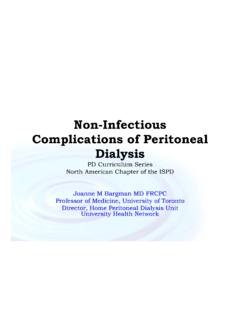Transcription of PD Catheter Placement and Management
1 PD Catheter Placement and ManagementRajnish Mehrotra1and John Crabtree21 Harbor-UCLA Medical Center, Torrance, CA and2 Kaiser Permanente, Bellflower, CA1 Importance of PD AccessStatus of PD Patients At One YearAll 55,587 incident PD patients in US, 1996-2003 Mehrotra et al, J Am Soc Nephrol 2007; 18: 2781-8A larger proportion of peritoneal dialysis patients transfer tohemodialysis every year, than the converse. In the first year, 12% of patients who start treatment with peritoneal dialysis transfer to hemodialysis. Many of the underlying causes of transfer to hemodialysis are preventable. Hence, while infectious complications still remain the most common reason for transfer of peritoneal dialysis patients to hemodialysis, Catheter -related problems are the second most common cause. Care taken at the time of Placement of the Catheter for peritoneal dialysis can minimize transfers to hemodialysis.
2 Thus, it is critical for the nephrology team to engage with the process to ensure appropriate Placement of peritoneal dialysis of Presentation Selection of PD Catheter : Design Issues Key Placement Issues: Who should place it? Key technical issues Management issues avoid temporary HD: Planned start of PD Emergent start of PD3 Why Is Design Or Surgical Technique Important? Reduce risk for Catheter -related complications Reduce risk for transfer to HDMechanical ComplicationsInadequate Hydraulic FunctionOmental EntrapmentLeaksInfectious ComplicationsExit-Site TunnelPeritonitis4 Catheter Material Catheters are made either of polyurethane or silicone rubber Exit-site, antibiotic prophylaxis either mupirocin or gentamicin - may damage polyurethane catheters Manifestations of Damage: Opacification of Catheter Leaks leading to peritonitis Rarely rupture of Catheter Know what the Catheter that is used at your center is made of; make sure to completely avoid polyurethane catheters ** Cruz polyurethane catheters were withdrawn from the market August 20105 Catheter Design IssuesIntra-Peritoneal SegmentTunneled SegmentExternal SegmentCrabtree J.
3 Kidney Int Suppl 2006; 70: S27-37A peritoneal dialysis Catheter can be considered to have three segments: The external segment the part that is outside the body and visible to us The tunneled segment the part of the Catheter that is tunneled through the subcutaneous tissue and the rectus muscle and The intra-peritoneal segment the part of the Catheter inside the peritoneal cavityWe will briefly review if design variations in each of the three segments have any effect on Design And OutcomesTunneled SegmentCuffs (Dacron)Superficial and/or deepMechanical anchorsnot microbiologicbarriersInter-Cuff SegmentStraightSwan-NeckThere are two variations to the design of the part of the Catheter that is tunneled the number of cuffs, and whether it has a pre-formed bend or not (swan-neck or straight respectively). There are no controlled data to recommend one variation in the design of the tunneled Catheter over other.
4 Two-cuff catheters provide anchorage at two different points the tunnel and are generally preferable over single-cuff catheters. Whether one uses a straight or swan-neck Catheter depends upon where you desire to have an exit site (see next slide for explanation)7 Catheter Design And OutcomesExtra-Peritoneal Segment Extended CathetersCrabtree J. Kidney Int Suppl 2006; 70: S27-37 Pre-Sternal CathetersUpper Abdominal Extended CathetersAs can be evident from the figure above, if the exit site is to be placed in the lower abdomen, a swan-neck Catheter is preferable (to avoid migration of the intraperitoneal tip for the Catheter to resume its default position). On the other hand, if the exit is to be placed pointing laterally, a straight Catheter is preferable over a swan-neck selected patients, exit site may be placed at either the upper abdomen or in the pre-sternal area.
5 8 Catheter Design And OutcomesIntra-Peritoneal SegmentThe four common variations in the intra-peritoneal segment are depicted in this slide. Each of these catheters has multiple small openings along the length of the Catheter tip this minimizes the jet effect at the time of instillation of dialysate. Most of the catheters that are used today have a coiled tip. There are no consistent data to support the superiority of any intraperitoneal Catheter design over other there is a single randomized controlled trial from Australia in which patients with a straight Catheter had a higher rate of transfer to hemodialysis secondary to inadequate solute clearances than those with a coiled tip Catheter (Johnson et al, Am J Kidney Dis, 2006). However, the biologic plausibility of these findings is uncertain and is insufficient to recommend any one intra-peritoneal Catheter design over of PD CatheterSummary Numerous design innovations.
6 No conclusive proof that one is superior to other Probably best to avoid polyurethane catheters entirely Two-cuff catheters with coiled intra-peritoneal segment most commonly used: Two cuff catheters may lower risk of Staph aureus peritonitis Selection of swan-neck or straight catheters may be determined by: Belt line and Placement of exit site Use of extended catheters or pre-sternal catheters is often dictated by body habitus10 Key Technical Issues Pre-operative antibiotic prophylaxis Location of the Catheter tip Placement of the deep cuff Placement of the exit site: Location on the abdominal wall Direction downward, lateral, or upward pointing? Location of superficial cuff relative to exit siteIt is important for the nephrology team to be involved in pre-operative Management , including marking the abdomen prior to the Placement of the PD Catheter .
7 It is best to mark the abdomenwith the patient standing upright and taking into account the patient s belt-line. The abdomen should be marked for:Location of deep cuffLocation of superficial cuffLocation of exit site11 Location of Catheter TipCrabtree J. Kidney Int Suppl 2006; 70: S27-37 Catheter Tip Location Deep Pelvic = pubic symphysisWhy?:Hydraulic function of Catheter ANDM inimize omental entrapmentIt is important that the tip of the Catheter be in the deep pelvis this ensures optimal hydraulic function of the Catheter and minimizes the risk for omental entrapment (lower right figure omental entrapment as seen on laparascopy).The landmark that corresponds to a deep pelvic location for the tip of the peritoneal dialysis Catheter is the pubic symphisis. Hence, when marking the abdomen pre-operatively, one can hang the Catheter against the abdominal wall such that the tip of the Catheter is at the level of pubic symphisis.
8 This would then allow you to mark the area on the skin where to make the surgical incision for entry into the peritoneal cavity in order to intercept the muscle layer at the proper level to insert the Catheter and position the deep of Deep CuffRectus MuscleParamedian position -away from the linea albaThe Catheter enters the peritoneal cavity just distal to the deep cuff. As said earlier, deep cuff should be located at a place that allows the tip of the Catheter to be in the deep pelvis. Furthermore, the entry point into the peritoneal cavity (and hence, the location of the deep cuff)) should be paramedian this ensures that the Catheter is not going through but linea alba (collagenous tissue in the midline that does not adequately close around the PD Catheter and increases risk for leaks).13 Principles in Fashioning Exit Site Should be away from belt-lines, skin creases, and folds Should be clearly visible to the patient to perform daily exit site care Inserted through the abdominal wall with least amount of tubing stress About one inch from the superficial cuff Generally achieved when planned with patient upright, rather than supineOnce the location of the Catheter tip and deep cuff is identified, the next steps would be to mark the abdomen for the location of the superficial cuff and the exit site.
9 The principles outlined in the slide above allow one to identify the correct Placement of the exit site, which in turn would allow identification of the appropriate site for the superficial Is It Relative to the Belt-Line?Need to Determine Before Patient SedatedAbove the Umblicus:Exit site below the umbilicusBelow the Umblicus:Exit site above the umbilicusIt is imperative to consider the belt-line when marking the abdomen for the location of the exit-site. In patients whose belt-line is above the umbilicus, the exit site should be located below the umbilicus. It is best achieved by using a swan-neck Catheter with the exit site pointed downwards. In contrast, in patients whose belt-line is below the umbilicus, the exit site is best located in the upper abdomen. This is best achieved with a straight Catheter with the exit-site pointed laterally. 15Is the Exit Site Visible?
10 Particularly Important for the ObeseShould be visible for a patient to perform daily exit=site carePictures Courtsey Dr. John Crabtree Kaiser BellflowerProper Placement of the exit site is particularly important for obese individuals it should be visible to the patient to perform daily exit site care and should not be buried under the pannus to prevent recurrent exit site infections. The best way to identify the correct site for the Placement of the exit site is pre-operatively, with the patient upright. When the patient is lying supine in the operating room, the pannus falls onto the side, making it difficult to identify the correct location for the exit two images on the left demonstrate an inappropriately placed exit site since it is buried under the pannus and not visible to the patient to perform daily exit-site are two alternative approaches that can be considered for obese patients upper-abdominal exit site ( demonstrated in the middle panel; may require the use of extended catheters) or pre-sternal catheters (right panel).














